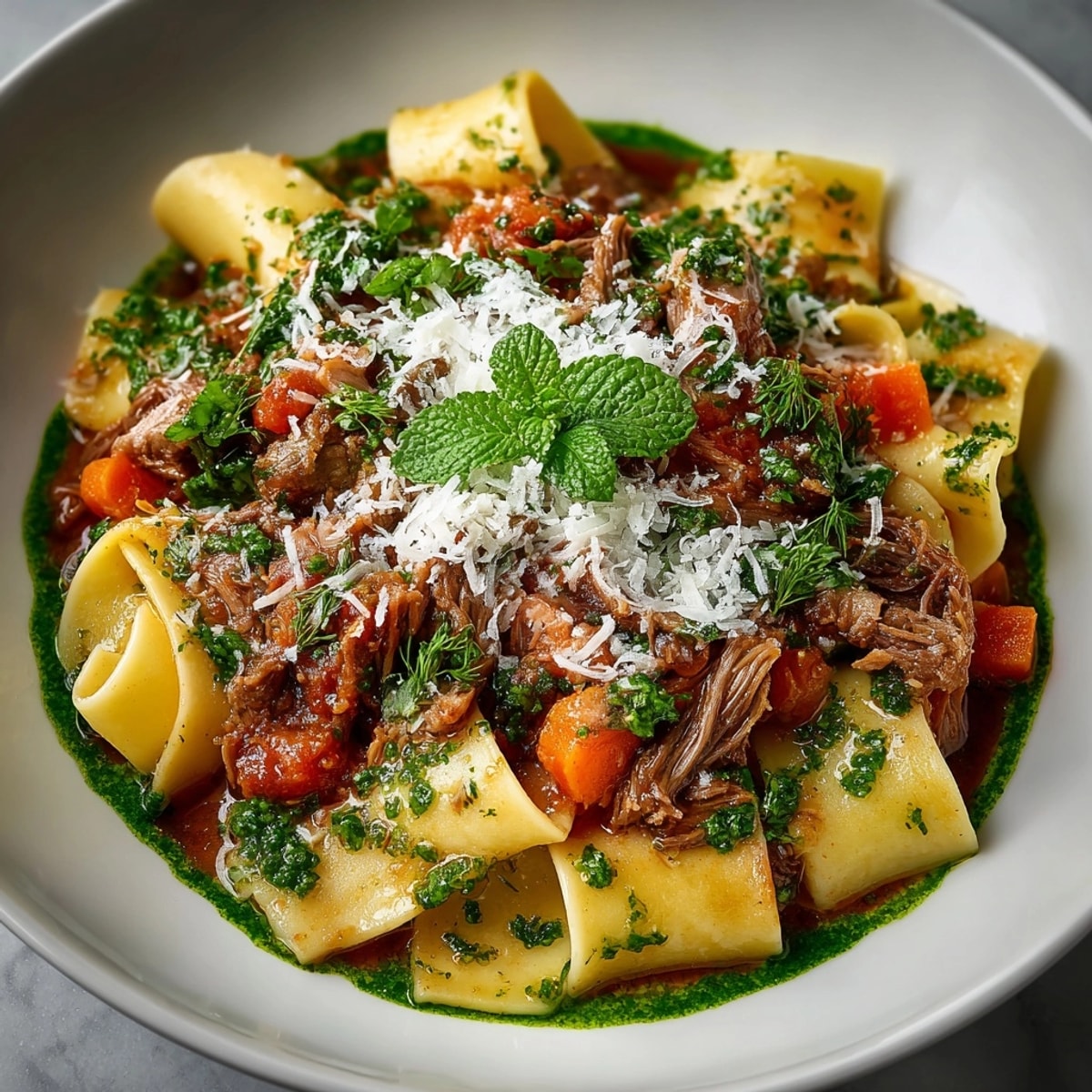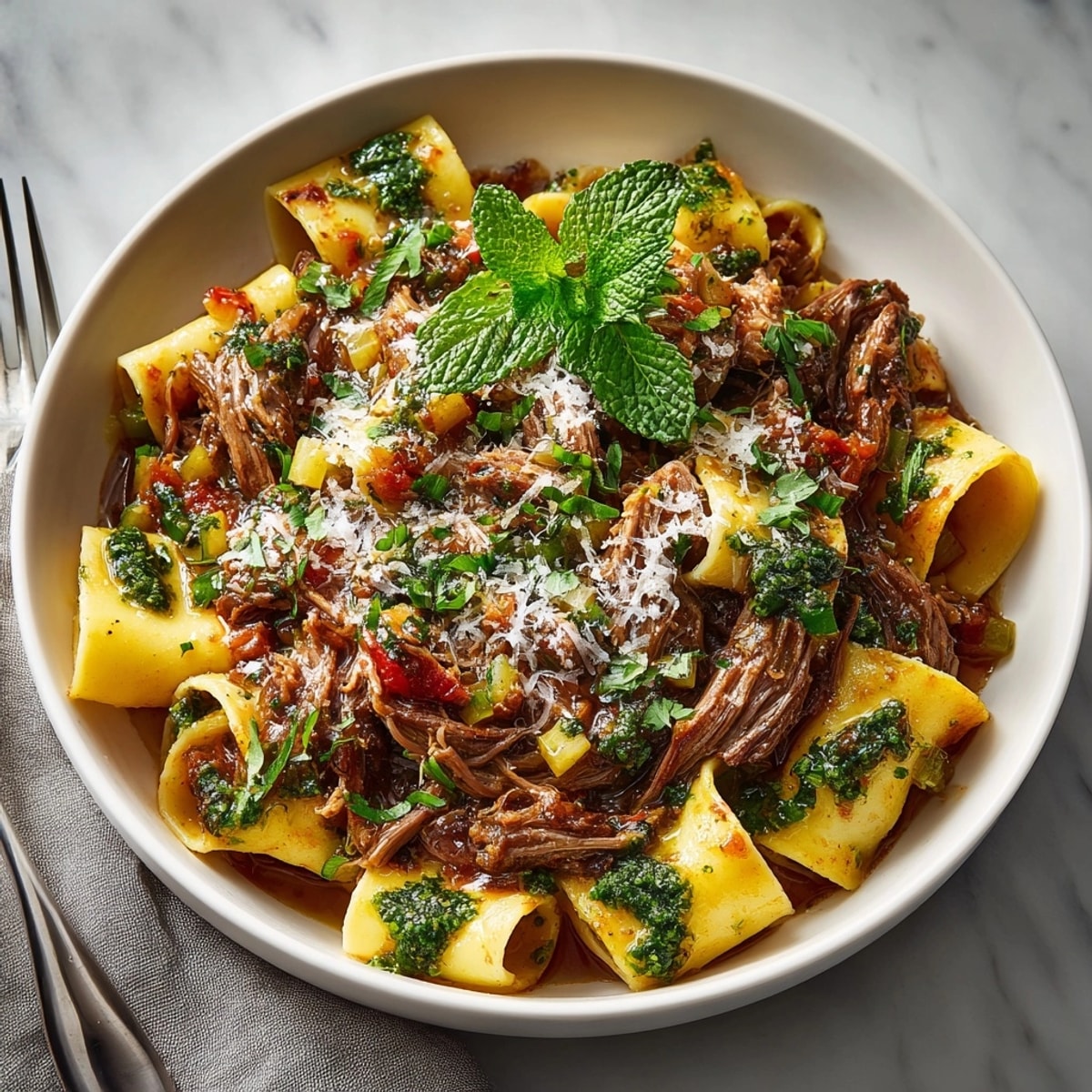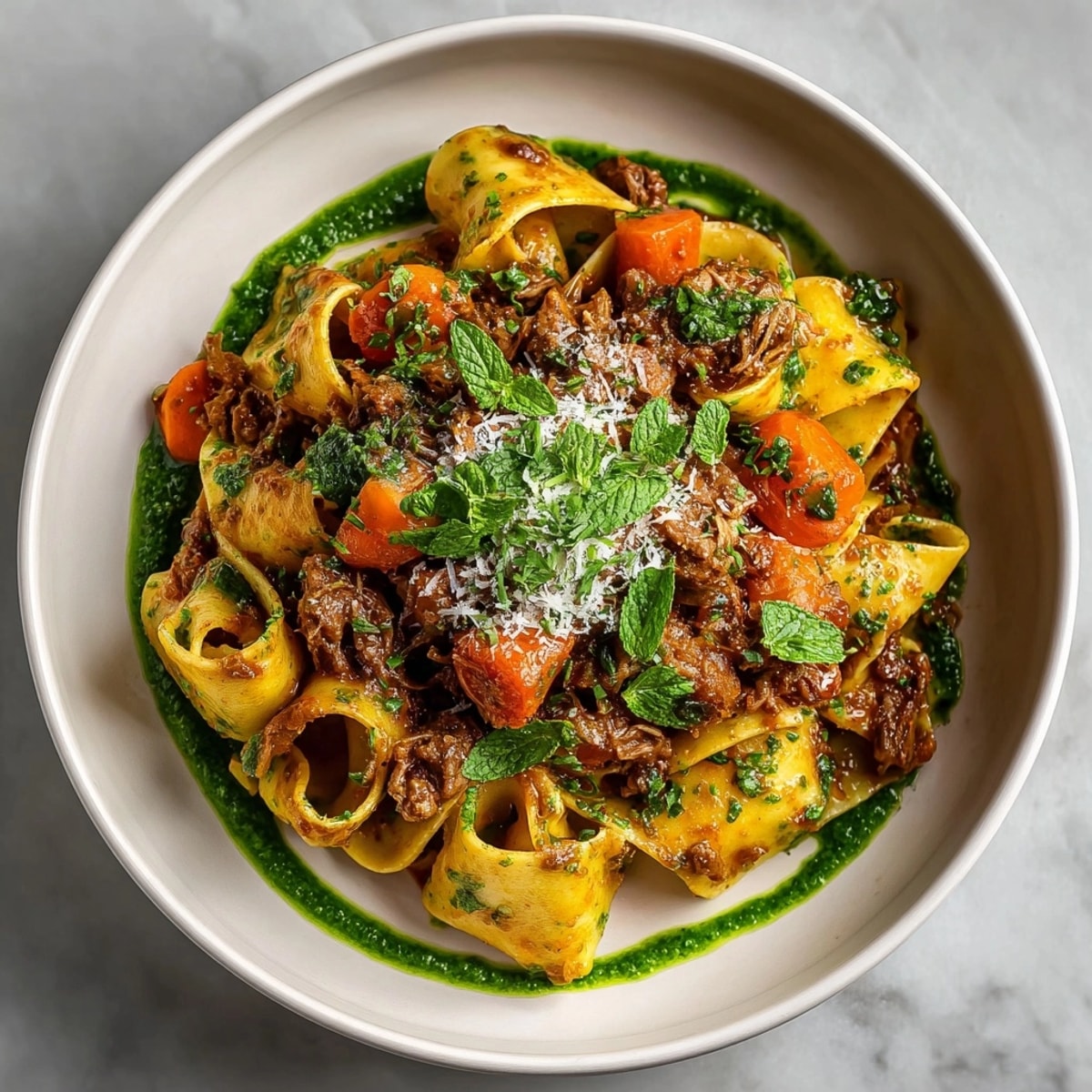 Save
Save This sumptuous lamb ragu pappardelle has been my family's special occasion dinner for years, combining tender slow-cooked lamb with wide ribbons of pasta and a vibrant mint oil that elevates the entire dish to restaurant quality right at home.
I first created this dish for my husband's birthday dinner after we returned from a trip to Tuscany, and it's become our tradition for celebrating milestones ever since.
Ingredients
- Boneless lamb shoulder: creates a melt in your mouth texture and develops deep flavor during slow cooking
- Mirepoix: the classic combination of onion carrot and celery builds an aromatic foundation
- Dry red wine: adds acidity and depth choose a Chianti or Sangiovese you'd enjoy drinking
- Fresh herbs: including rosemary thyme and mint provide layers of aromatics that make this dish special
- Pappardelle pasta: these wide ribbons are perfect for catching the rich sauce look for bronze die extruded for the best texture
- Extra virgin olive oil: use your best quality for the mint oil as its flavor will shine through
Instructions
- Sear the Lamb:
- Heat olive oil until shimmering in a Dutch oven over medium high heat. Season lamb cubes generously with salt and pepper. Working in batches to avoid crowding, place lamb in a single layer and sear until deeply browned on all sides about 3 minutes per side. This step creates the foundation of flavor through browning reactions. Transfer browned lamb to a plate.
- Build the Flavor Base:
- Reduce heat to medium and add the diced onion, carrot, and celery to the same pot. Cook in the lamb drippings for 5 to 7 minutes, stirring occasionally until vegetables soften and begin to caramelize. The vegetable mixture should take on a golden hue and smell wonderfully aromatic.
- Develop the Aromatics:
- Add minced garlic and tomato paste, stirring constantly for about 1 minute. The garlic should become fragrant but not brown, and the tomato paste will darken slightly as it caramelizes, intensifying the umami flavor base.
- Deglaze the Pot:
- Pour in the red wine and use a wooden spoon to scrape up all the flavorful browned bits from the bottom of the pot. Allow wine to simmer and reduce by about half, approximately 2 to 3 minutes. The alcohol will cook off leaving behind concentrated flavor.
- Slow Cook to Perfection:
- Return the browned lamb to the pot along with crushed tomatoes, stock, rosemary, thyme, and bay leaf. Bring everything to a gentle simmer, then reduce heat to low. Cover and cook for 1.5 to 2 hours, stirring occasionally. The lamb is ready when it easily shreds with a fork and the sauce has thickened to coat the back of a spoon.
- Create the Mint Oil:
- While the ragu cooks, combine fresh mint leaves with high quality olive oil and a pinch of salt in a blender. Process until completely smooth about 30 seconds. Strain through a fine mesh sieve, pressing gently to extract all the oil. The resulting bright green oil should be vibrant in both color and flavor.
- Cook the Pasta:
- Bring a large pot of water to a rolling boil and salt it generously until it tastes like the sea. Cook pappardelle according to package directions until al dente, typically 8 to 10 minutes for dried or 2 to 3 minutes for fresh. Reserve 1/2 cup of the starchy pasta water before draining.
- Combine and Serve:
- Gently toss the cooked pappardelle with the lamb ragu, adding splashes of reserved pasta water as needed to create a silky consistency. Divide among warmed plates, spooning additional ragu over each portion. Finish with an artistic swirl of mint oil and garnish with freshly grated Parmesan and mint leaves if desired.
 Save
Save My absolute favorite element of this dish is the contrast between the rich, deeply savory lamb ragu and the bright, aromatic mint oil. The first time I served this to my Italian grandmother, she was skeptical about the mint addition but ended up asking for the recipe before the meal was even finished.
Make Ahead Strategy
The beauty of this lamb ragu is that it actually improves with time. You can prepare the entire ragu portion up to three days in advance and refrigerate it in an airtight container. The flavors will continue to meld and develop complexity as it rests. When ready to serve, gently reheat the ragu on the stovetop while you prepare fresh pasta. The mint oil can also be made a day ahead and kept refrigerated, though it's best to bring it to room temperature before serving for the most vibrant flavor.
Ingredient Substitutions
If lamb isn't your preference or readily available, this ragu works beautifully with beef chuck roast or even pork shoulder, though each will lend a different character to the final dish. For a lighter version, ground lamb can be substituted for the cubed shoulder, reducing the cooking time to about 30 minutes. While pappardelle is traditional and ideal for catching the sauce, other wide noodles like fettuccine or tagliatelle make excellent alternatives. For a gluten free option, seek out chickpea or rice based pappardelle, or serve the ragu over creamy polenta instead.
Seasonal Adaptations
In summer months when mint is abundant in the garden, double the mint oil recipe and save the extra to drizzle over grilled vegetables or summer salads. During winter, intensify the warming qualities by adding a cinnamon stick and a few whole cloves to the slow cooking process, removing them before serving. In spring, consider stirring in some fresh peas just before serving for bursts of sweetness and color. Fall calls for the addition of wild mushrooms, sautéed separately and folded into the finished ragu for an earthy dimension that complements the lamb beautifully.
 Save
Save Wine Pairing Suggestions
This robust lamb ragu calls for an equally characterful wine companion. A Tuscan Chianti Classico Riserva offers the perfect balance of acidity to cut through the richness while complementing the tomato base with its own notes of cherry and herbs. For something more robust, look to a Montepulciano d'Abruzzo with its dark fruit character and subtle spice notes that echo the herbs in the dish. If you prefer something from outside Italy, a Syrah from the northern Rhône brings peppery notes that enhance the lamb's natural flavors while standing up to the dish's intensity.